Almost three decades ago, the US Mint produced the 1995 nickels. It is part of the Jefferson nickel variety, first issued in 1938. Your quest to add new coins to your collection might have brought you here. Perhaps, you are curious and want to learn more about the 1995 nickel coin.
Whatever your reason, read on to know the historical milestone, value, description, and design of the 1995 Jefferson nickel.
What Is the 1995 Jefferson Nickel Made Of?
The 1995 Jefferson nickel is made of 75% copper and 25% nickel. To be specific, the core of the 1995 nickel is made of copper while it is clad or covered with nickel all around its surface. The nickel gives the nickel its distinct shine and beauty.
Since the Jefferson nickel was first issued, it has always been made with copper and nickel. This changed during World War II when nickel was highly in demand on the battlefield.
Congress asked the US Mint to save all the nickels. In response, the US Mint turned the composition of the 5-cent coin from cupro-nickel to copper, silver, and manganese. After the war, the composition was restored to copper and nickel.
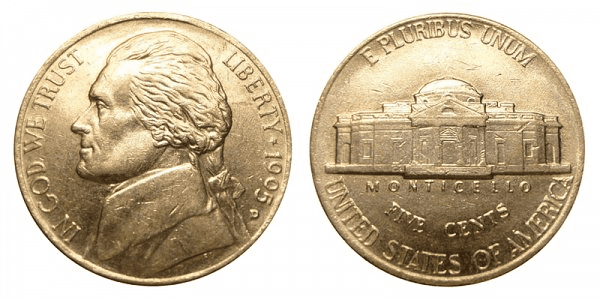
The nickel’s design features the third US president, Thomas Jefferson. Felix Schlag designed it. From 1938 to 2004, Schlag’s design was used. Today, the Jefferson nickel uses the design of Jamie Franki.
The obverse (head) of the 1995 nickel features the left profile of Jefferson, while the reverse (tail) features the mansion of Jefferson called the Monticello.
1995 Jefferson Nickel Varieties
The 1995 Jefferson nickel comes with three varieties and a few error coins. Here’s a quick look at the varieties with their mintage:
| Variety | Mint Location | Mintage |
| 1995 D Jefferson Nickel | Denver | 888,112,000 |
| 1995 S Proof Jefferson Nickel | San Francisco | 2,797,481 |
| 1995 P Jefferson Nickel | Philadelphia | 774,156,000 |
| Total | 1,665,065,481 |
As you can see, more than 1.6 billion nickels were produced in 1995. This is higher than the mintage figure in 1994.
Here’s a deeper look at the different 1995 Jefferson nickel varieties:
1995 D Jefferson Nickel
Year of minting: 1995
Mint Mark: D
Minted in: Denver
Quantity produced: 888,112,000
Face Value: $0.05 (five cents)
Price: $0.56 to $1.13 (circulated condition)
Mass: 5.00 grams
Edge: Plain
Designer: Felix Schlag
Composition: 75% Copper, 25% Nickel
Diameter: 21.20 millimeters
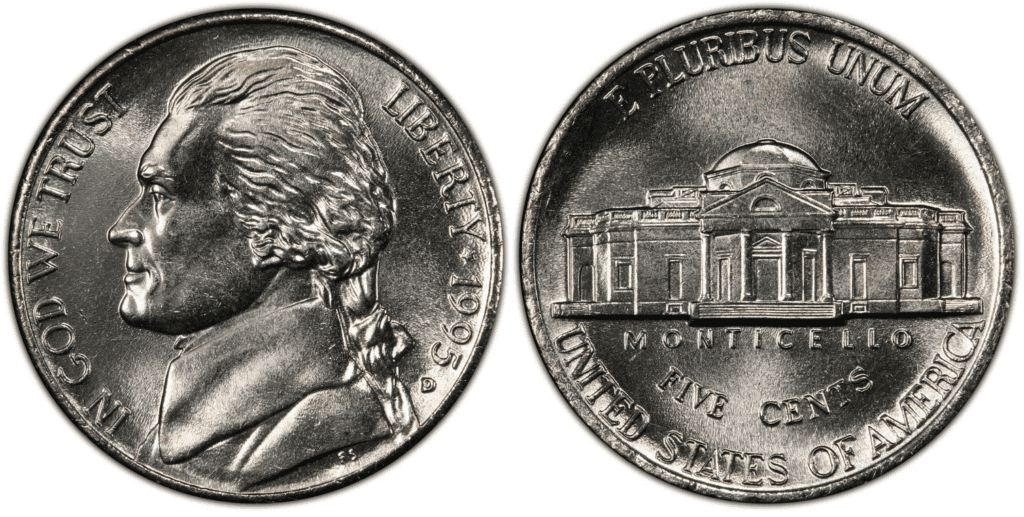
With more than 888 million nickels produced in 1995, the Denver Mint surpassed the Philadelphia Mint regarding mintage figures. The Denver Mint also produced more nickels in 1995 than the previous year. A circulated 1995 nickel may be priced at around $0.56 to $1.13.
1995 S Proof Jefferson Nickel
Year of minting: 1995
Mint Mark: S
Minted in: San Francisco
Quantity produced: 2,797,481
Face Value: $0.05 (five cents)
Price: $5.70 or more (Mint State)
Mass: 5.00 grams
Edge: Plain
Designer: Felix Schlag
Composition: 75% Copper, 25% Nickel
Diameter: 21.20 millimeters
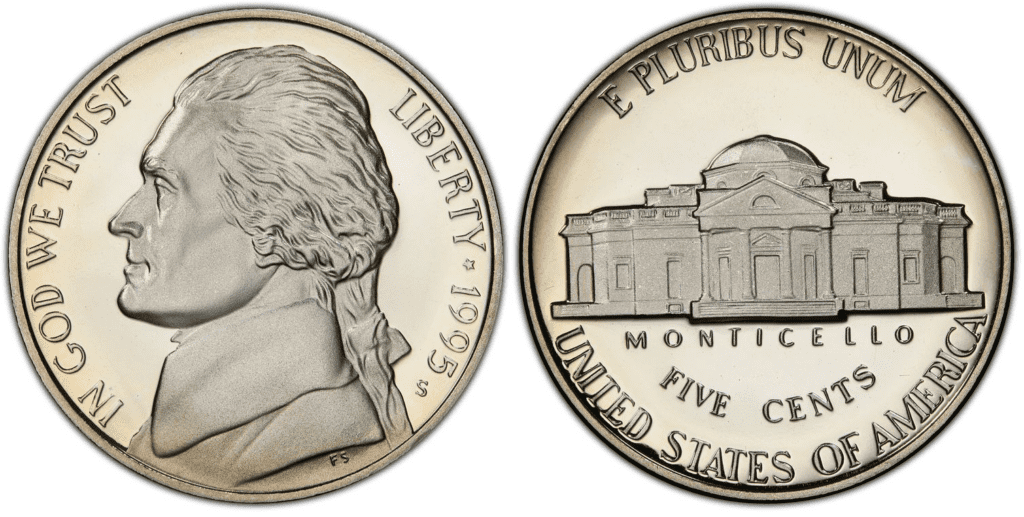
The 1995 S proof nickels are nicely struck. There were plenty of 1995 S-proof coins, and more than 2.7 million proof coins were produced.
Because of its high mintage, the 1995 nickel should easily be found. Even 1995 S-proof nickels are common in PR70 Deep Cameo grade. With a great supply, the price should be affordable.
1995 P Jefferson Nickel
Year of minting: 1995
Mint Mark: P
Minted in: Philadelphia
Quantity produced: 774,156,000
Face Value: $0.05 (five cents)
Price: $0.28 to $1.13 (circulated condition)
Mass: 5.00 grams
Edge: Plain
Designer: Felix Schlag
Composition: 75% Copper, 25% Nickel
Diameter: 21.20 millimeters
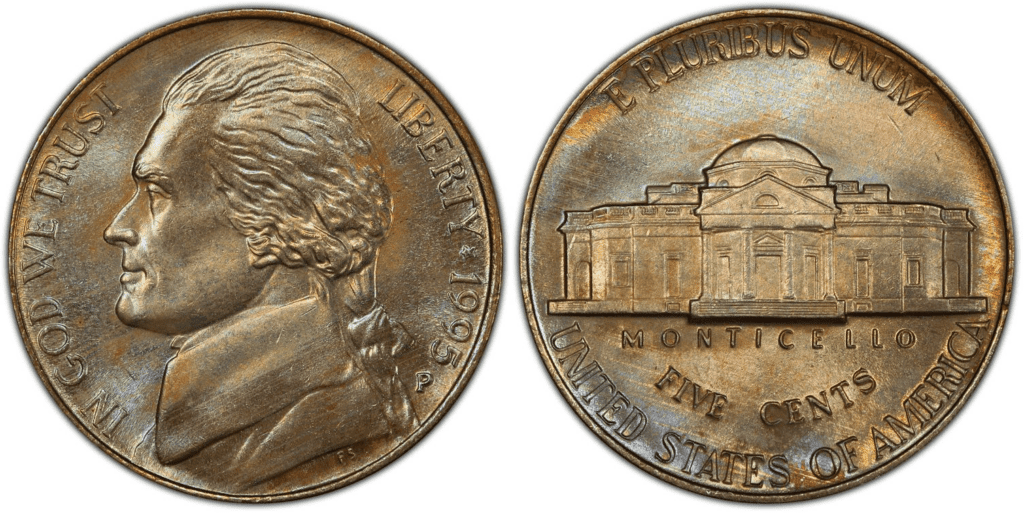
The 1995 P nickel was struck in the Philadelphia Mint. there were almost 775 million of these nickels. This is higher compared to the mintage figure for the previous year.
List Of 1995 Jefferson Nickel Errors
With more than 1.6 billion Jefferson 5-cent coins produced in 1995, it is unsurprising that error coins would happen anytime.
The US Mint tried its best to reduce or eliminate error coins, but coin collectors are especially interested in them. After all, error coins are unique and interesting. You can never know what type of error you get.
To give you an idea, here are some of the most common examples of error coins:
Broadstrike error
Broadstrike errors happen when the die collar doesn’t properly hold the planchet. When the die hits the planchet, it becomes flat since nothing is holding it, and the coin spreads outward.
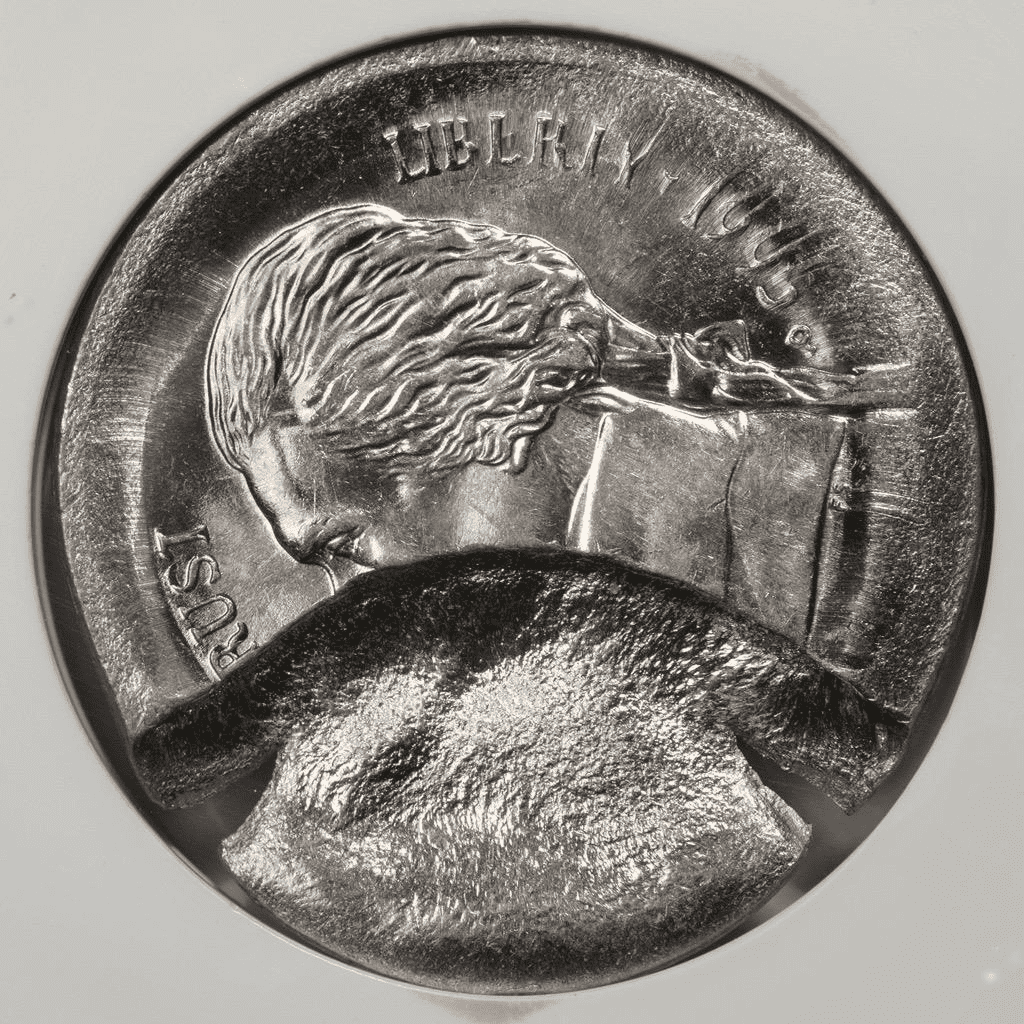
You can see that the part from the head to the back of Jefferson looks flat.
Off-center error
The die should hit the planchet straight to its center. When this fails to happen, an off-center error occurs. This usually happens when the planchet isn’t properly positioned.
The off-center error can be a little off. However, there are times when the error is so obvious. Here’s an example of an off-center error:

Improperly Annealed Planchet
The 1995 nickel can have a discolored portion on its surface. Different factors can cause this, but one is an improperly annealed condition. This happens when the metal molecules migrate in one specific area, causing a different shade of color.
Die break error
There are times when the die breaks because of wear and tear. As you can imagine, thousands of 1995 nickels are being struck all day. There will come a time when the die breaks and causes some errors.
When this happens, the crack on a broken die can leave a mark on the coin after the strike. The mark can look like small to big lines on the coin.
Doubled die errors
Doubled die obverse (DDO) or doubled die reverse (DDR) is an error coin where the die hits the coin twice. If the second strike was of a different angle, you will see a doubled appearance on the coin.
How Much Is 1995 Jefferson Nickel Worth Today?
The face value of the 1995 Jefferson nickel is 5 cents. It has a melt value of $0.0710. The Jefferson nickel doesn’t have any precious metal in it, like silver or gold. So, it is understandable that it doesn’t have a higher price when sold. Circulated coins can be just around $0.28 to $1.13.
While yes, it is true that the 1995 nickel might not have a huge intrinsic value, it is still valuable in the eyes of collectors, especially if the coin comes in good condition.
Check out this table of auction records below, which is based on the PCGS website. You’ll see that the 1995 Jefferson nickel can still be worth a lot of money.
| Coin | Condition | Grade | Sold date | Sold by | Value |
| 1994 D Jefferson Nickel | Superb Gem Uncirculated | MS 67 | January 12, 2005 | Heritage Auctions | $1,495 |
| 1994 S Proof Jefferson Nickel | Perfect Uncirculated
|
PR 70 – DCAM | August 12, 2004 | Heritage Auctions | $690 |
| 1994 P Jefferson Nickel | Superb Gem Uncirculated | MS 67 – Full Steps | August 11, 2011 | Heritage Auctions | $546 |
As you can see, the 1995 nickel can still be valuable. Be alert as well with error coins. Some of these coins come with a higher price because of their unique characteristics.
How Does The Grading System Work?
The 1995 nickel is graded based on its appearance, luster, and strike. When grading, most appraisers would use the Sheldon Scale. This scale is a 70-point grading system that helps people know the condition of their coin by just looking at its grade.
Aside from the numerical grade, you also have the letter designations that include PR and MS. PR is given to coins originally made as proof coins. On the other hand, the MS designation means that the coin was made for circulation but is still in great condition.
You can get your 1995 nickel graded by coin-grading service providers such as PCGS and NGC. Once your coin is officially graded, it can dramatically increase its value.
Where To Buy Or Sell 1995 Jefferson Nickel?
The 1995 Jefferson nickel is available online and in-store.
A simple Google search would help you find 1995 5-cent coins. You should then find specialized websites for coin collection. These may include USA Coin Book, Grey Sheet, and Coin Trackers. Aside from that, you can head to Amazon and eBay to immediately find 1995 Jefferson coins.
While the Internet is a great place to find your needed coins quickly, you should be wary of scams. Aside from that, you would need to wait for your coin to arrive since shipping may take days. Finally, consider that buying online means you cannot physically check the coin. You would need to rely on pictures and videos.
If all of these are too complicated, consider buying in person. Some of the most common places to buy would be coin shops, antique stores, pawnshops, and auction houses.
FAQs
Where is the mint mark on a 1995 nickel?
The mint mark on the 1995 nickel can be found on the obverse side of the coin. You should find it near the pigtail of Jefferson and the number “5” of the year 1995.
How much should a 1995 nickel weigh?
The 1995 nickel weighs 5 grams.
Is a 1995 nickel rare?
No, the 1995 nickel is not rare. The US Mint issued more than a billion 1995 nickels. However, 1995 nickels with MS67 or PR67 and above grades could be considered rare.
